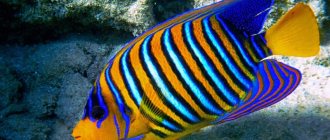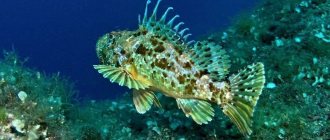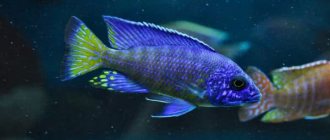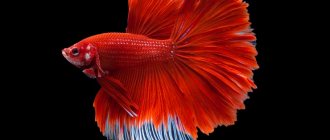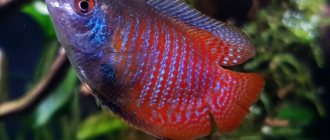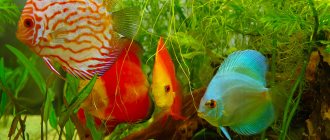10/18/2019Pisces0
Transparent fish got their name due to the lack of reflective scales and the ability to transmit light through themselves. This feature helps them not only hide from predators, but also preserve valuable resources in their natural habitat. To date, many of their species have been studied, some of which have become popular among aquarists.
- 1 Mr. Tail Recommends: Varieties
- 2 Description and natural range of the Transparent Perch
- 3 How to decorate an aquarium with glass fish
- 4 Basics of aquarium keeping
- 5 Compatibility
- 6 Feeding
- 7 Breeding
- 8 Diseases and prevention
Mr. Tail recommends: varieties
Transparent fish are found among different families of marine life. The following have become popular:
- Indian perch (Parambassis ranga) has a body of 8-10 cm, along which a purple stripe stretches. In males it is olive in color, and in females it is silver. Breast feathers are red.
- The largemouth bass (Parambassis pulcinella) is distinguished by a rounded outgrowth that hangs over the forehead. The oval body (8 cm) is flattened at the sides. The scales are golden with chaotically scattered dark spots.
- Threaded perch (Gymnochanda filamentosa, Glass angel) is distinguished by a body up to 3 cm in length and thin fins. There are dark stripes on the sides, and large eyes on the reddish head.
- Indian catfish (Kryptopterus vitreolus) grows up to 10-15 cm. In the lower part there is an anal fin along the entire length. There is a pair of mustaches on the head. Its African cousins have longitudinal black stripes and 4 barbels on the nose.
- Tetra (Prionobrama filigera) has a translucent grayish body with a longitudinal green stripe. It is very elongated, reaches 6 cm and ends with a blood-red tail.
- The ridley pristella (Pristella maxillaris) is called star-shaped due to its golden color with yellow-black stripes on its fins and a red tail. Its body is 4-4.5 cm, high and flattened on the sides.
- The glass knifefish (Eigenmannia virescens, Glass Knifefish) resembles a blade and grows up to 30 cm long. With age, it acquires color and an electromagnetic field. An anal fin runs along the body, but the others are absent.
- Charax condei has a diamond-shaped body of a golden hue, covered with dots and strokes, with a longitudinal stripe. Grows up to 7 cm long. He himself is a predator, and invisibility helps him in the hunt.
There are also small Amazon fish, the amazing Smallmouth micropinna with a translucent head, Golomyanka native to Baikal, consisting of 35% fat. Due to their structural features, they are unsuitable for home breeding, but they never cease to amaze with their beauty. In addition to fish, jellyfish, glass frogs and squid, Indian shrimp, mollusks Angelfish, Salpa Maggiore and sea cucumber have an unusual structure.
Photo gallery of Transparent fish:
Fish from New Zealand
A few years ago, an ordinary New Zealand fisherman named Stuart Fraser discovered to the world another unusual creature that no one had been able to notice before. The fish was completely glass, so at first the fisherman mistook it for an ordinary plastic bag, which held on to the surface of the water with all its strength.
Only after taking a closer look did Fraser notice that the creature was alive. Despite the fact that the fisherman had never seen anything like this before (having considerable fishing experience behind him), ordinary human curiosity prevailed, and Stuart Fraser risked taking the unknown creature in his hands and taking a closer look.
The fish is completely transparent
The fish turned out to be completely transparent and had scales consisting of some kind of jelly-like substance, due to which the creature resembled a jellyfish. The organs of the unusual creature were also transparent, except for one of them, which was red and had a small teardrop shape.
It was not possible to study the fish in more detail - after observing the unusual creature and taking several photographs, Fraser released it into its native element.
Salpa Maggiore
Later, thanks to the knowledge of the director of the National Marine Aquarium, Paul Cast, it was possible to establish that Fraser's find was none other than a transparent fish, scientifically named Salpa Maggiore.
Moves only on the surface of the water
This type of marine life has a number of external similarities with jellyfish, despite the fact that it has nothing in common with them. It has internal organs - a heart and filters that pass water and necessary food (plankton, algae and small cells) through the body of a transparent fish, as well as gills that allow breathing under water.
Representatives of Salpa Majora have no sex and are capable of independently reproducing offspring. Typically, such fish do not move alone, preferring to form massive schools - this makes it much easier for them to escape from predators and exist normally.
Unlike many transparent representatives of bodies of water, Salpa Maggiore is absolutely safe, although it looks like a terrible creature from monster movies. It feeds on algae or ordinary plankton, and the lack of color pigment serves only as protection from larger marine life. Salpa Maggiore lives primarily on the surface of the water , which makes it easy prey for predators and fishermen.
All organs of the fish are visible
Features of fish
Salpa Maggiore is one of the most unknown and amazing inhabitants of sea waters. Very, very little information has been collected about her. What is known is that the fish is an invertebrate and is shaped like a small barrel. It mainly lives in the Southern Ocean, in the cold waters of which it moves by pumping liquid through its body.
In addition to the heart, through the transparent body of the fish you can see the intestines and circular muscles, as well as two openings of the siphons - the oral (leading to the pharynx) and the cloacal. The siphons are located opposite each other, at opposite ends of the fish's body.
Description and natural range of the Transparent Perch
The species and geography of distribution of Transparent fish around the globe are so diverse that it is simply not possible to describe them all here; this requires separate articles for each species.
Here is a description of the most popular aquarium pet from the Glass Fish series.
This representative of the Okunev family has a number of characteristic features:
- Through the transparent matte body, 25 vertebrae, gills and entrails, covered with a shiny protective membrane, are visible.
- The flat body has a diamond shape with a slightly concave forehead, which gives smooth movement.
- The dorsal fin changes from a triangular part to a rounded part, which is symmetrical to the anal part.
- The swim bladder located near the belly is pointed in males, while in females it is rounded.
This description makes it possible for perches to camouflage themselves, hiding from predators. In their natural environment they can be found in the following bodies of water:
- Indians, native to India and Pakistan, prefer rivers, streams, lakes and swamps, standing or with a slight current, with dense vegetation.
- Bigheads live in fast-water rivers and streams of Myanmar or Thailand, preferring an active lifestyle.
- The filamentous species are native to Southeast Asia and live in peat bogs and river marshes in Malaysia.
As you can see, such animals prefer fresh water to sea water, which makes home breeding much easier.
sea angels
Angelfish are molluscs native to the Arctic Ocean whose scientific name is Gymnosomata
translated from Greek as “naked body.”
They were named sea angels because they appear to flutter through the water using tiny transparent wings
.
Angelfish are hermaphrodites and feed on other species of winged molluscs known as "sea butterflies."
How to decorate an aquarium with glass fish
The water environment should not only be beautiful, but comfortable and safe for its inhabitants. To ensure this, you need to follow these instructions:
- Pour dark river sand or crushed polished gravel onto the bottom to replace the soil.
- Place driftwood from mangrove trees, artificial houses, caves and other interior elements suitable for shelter.
- For Glass Angels or Tetras, you can add oak or beech leaves and branches to bring the conditions closer to natural.
- Densely plant plants accustomed to salty water, such as hornwort, fern, vallisneria, and Java moss.
- Provide bright lighting for Perch and Catfish, and dim lighting for Kharacinovs, with shaded areas.
The abundance of vegetation and decorative items will not only allow the fish to hide, but will also help them to have privacy during the mating season.
Reviews
Aquarists speak positively about transparent catfish, but note that they pose some difficulties in keeping them. Another drawback is the secrecy and invisibility of the representatives; a significant part of the time the pets hide in vegetation and shelters.
Aquarium Basics
To provide your pets with optimal care, it is worth maintaining certain water quality indicators and regularly filtering and aerating it. It is also necessary to replace 10% of the liquid daily with pre-settled liquid.
| Name | Number of fish | Min. aquarium volume, l | Water parameters | ||
| t °С | pH | gH° | |||
| Indian grouper | 6-15 | 50 | +20…+27 | 6,5-8,5 | 8-20 |
| Bighead Bass | 6-10 | 50 | +24…+27 | 7,0-9,0 | 5-15 |
| Threaded perch | 8-10 | 100 | +20…+28 | 4,0-6,0 | 1-5 |
| Indian catfish | From 6-8, better 10-20 | 150-200 | +23…+26 | 6,5-7,5 | 5-6 |
| Glass Tetra | 6-12 | 70 | +22…+28 | 6,0-7,5 | Up to 15 |
| Pristella ridley | From 6 | 50-70 | +23…+28 | 6,0-8,0 | 2-30 |
| Charax Conde | 6-10 | 80-100 | +23…+25 | 6,0-7,5 | 3-10 |
| Glass knife | From 5 | 200 | +20…+30 | 6,0-7,0 | 2-15 |
Some representatives of the Okunev and Somov families are initially accustomed to brackish water. If necessary, you can adapt to new parameters by placing purchased pets in quarantine and gradually diluting the liquid in the container.
Compatibility
Transparent fish are schooling by nature. But not all of them tolerate neighbors of other species. For example, it is appropriate to keep perches with catfish, tetras, bee gobies, zebrafish, bots, nannacaras and rasboras while providing a fresh environment. In salted water, it is better to place them next to guppies and mollies. Neons, small cichlids or gouramis, swordtails and minors are also considered reliable neighbors for catfish.
In turn, the Glassy Perch does not like neighbors, so their presence should be minimized. The same can be said about Charax Kond, but for different reasons. This is a predatory fish that should be kept in a species aquarium.
Price
The cost of glass aquarium fish varies depending on the type and store. The average price starts at 90 rubles per piece. Purchases are possible through online stores with delivery or in regular pet stores.
Transparent fish are exotic pets with a pleasant appearance that can be a good choice even for people without much experience in keeping fish. Some consider their appearance strange and frightening.
What do you think? Share your opinion in the comments.
Feeding
In the natural environment, transparent fish consume live food, so when bred in aquariums, dry food will not be popular with them, and in some cases will lead to infertility. In general, you can diversify their diet with frozen bloodworms, daphnia, small crustaceans, tubifex, coretra or cyclops.
Catfish and perch prefer floating food, which is due to the structure of their mouths. They pick up food from the bottom clumsily, lying on their sides. Fry can be fed with specially formulated microflakes or small bioplankton.
History of the discovery of the species
Neons owe their current popularity to the French explorer Auguste Rabot, who was the first to draw attention to small luminous fish swimming in the Putumayo River. He was so attracted by the unusual beauty of the inhabitants of the reservoir that he decided to start exporting them.
In 1935, the first neons were transported to the USA and Europe, where they immediately captivated local aquarists. The fish immediately became mega-popular, and Rabo became their only supplier to the New and Old Worlds. The business of the enterprising Frenchman also flourished because neons could not be bred in captivity for a long time.
Some of the first luminous fish were given as a gift to William Innesi, and he shared them with his friend George Myers. It was the latter who was the first to make a scientific description of ordinary or blue neon and named it in honor of his friend - Hyphessobrycon innesi. The species was later renamed Paracheirodon innesi.
Red neons were discovered only in the middle of the 20th century. Moreover, their description was made by two scientists at once, Schultz and Myers. But the work of the first was published earlier, so the species received the name given to him - Paracheirodon axelrodi.
In 1963, Jacques Gehry discovered emerald neon, also called simulant neon. The fish he discovered was similar to the red neon, but in the course of further research it was classified as a separate species.
The first offspring from neons living in captivity were obtained in Germany thanks to a happy accident. The fact is that in this country very soft water flows from the taps, which is used to keep fish. The first spawning of neon in captivity was dubbed the “German miracle,” but as a result of the study, experts discovered a connection between water parameters and the reproduction of Paracheirodon.
Breeding
Transparent fish reach maturity at 4-6 months of life. Under optimal conditions, they are able to reproduce by laying eggs in secluded corners of plants. The ratio of males and females should be 1:2.
The most suitable time for this is early spring or late autumn, when the food becomes most nutritious for the fry.
During this period, you can add floating vegetation to the aquarium and provide a spawning space of at least 50-80 cm for one or several pairs. The water needs to be changed regularly and lightly added, and its temperature must be increased a couple of degrees.
After spawning, the female and male should be transplanted into another container. The incubation period is 3-4 days, and then the fry appear, which within 3 months grow by 1.5 cm. Change the water for them carefully, introducing it by drip. Lighting needs to be constant, as are other parameters.
Character traits
The fish can be peace-loving, but at the same time it is characterized by a tendency to get scared. It is recommended to abandon a densely populated aquarium, since such living conditions immediately lead to severe stress.
The fish can live at any water level. Moreover, it can remain motionless for a long time, and in such situations there is no need to fear for the health of your pets. After a while, the perch will certainly make an impetuous movement and move to another location. If you want to observe the behavior of fish, you need to select at least eight individuals and provide them with a large aquarium. Given enough space, males can define personal territories where they will eagerly await females to breed.
High-quality care will allow the fish to live for two to three years.
Diseases and prevention
Fish diseases penetrate through damage to the skin from the outside. In particular, after artificial dyeing of fabrics, which is used by some sellers. It shortens the lifespan of pets by up to a year.
Among the most common pathologies are:
- Ichthyophthyriosis (“white dot”, “semolina”) is caused by the ciliates ichthyophthirius multifiliis. The first signs are white bumps all over the body and lack of oxygen. Malachite and Diamond greens, Violet K (Chlorohydrite) are suitable for therapy.
- Fin rot (pseudomonosis) occurs due to Pseudomonas bacteria, which develop when the temperature drops and the biological balance is disturbed. Manifests itself in the form of rot on the fins. It is treated with Tripaflavin (1:10000), Morphocycline and silver nitrate.
- Lymphocystis (lymphocystis) is caused by the LCDV virus. Manifestations include warts and nodules on the fins, skin and gills. It goes away within a few weeks under suitable conditions.
Treatment should be carried out by a qualified veterinarian. And in order to prevent pets from getting sick, a number of preventive measures should be taken:
- Quarantine purchased fish for up to 0.5-2 months.
- Replace up to 25% of water every week.
- Clean glass and decorations from deposits.
- Plant excess fish without allowing overcrowding.
- Remove traumatic decorative elements.
- Feed regularly 1-2 times a day.
Creating optimal conditions that are close to natural will avoid many problems. And careful attention to pets will ensure their maximum life expectancy of up to 3-4 years.

